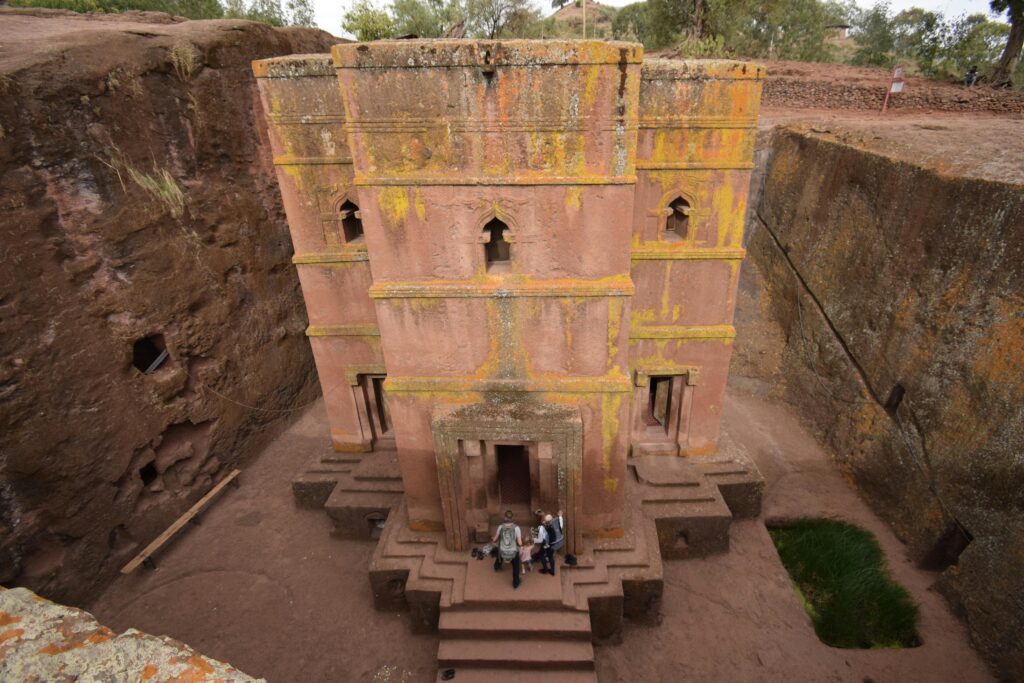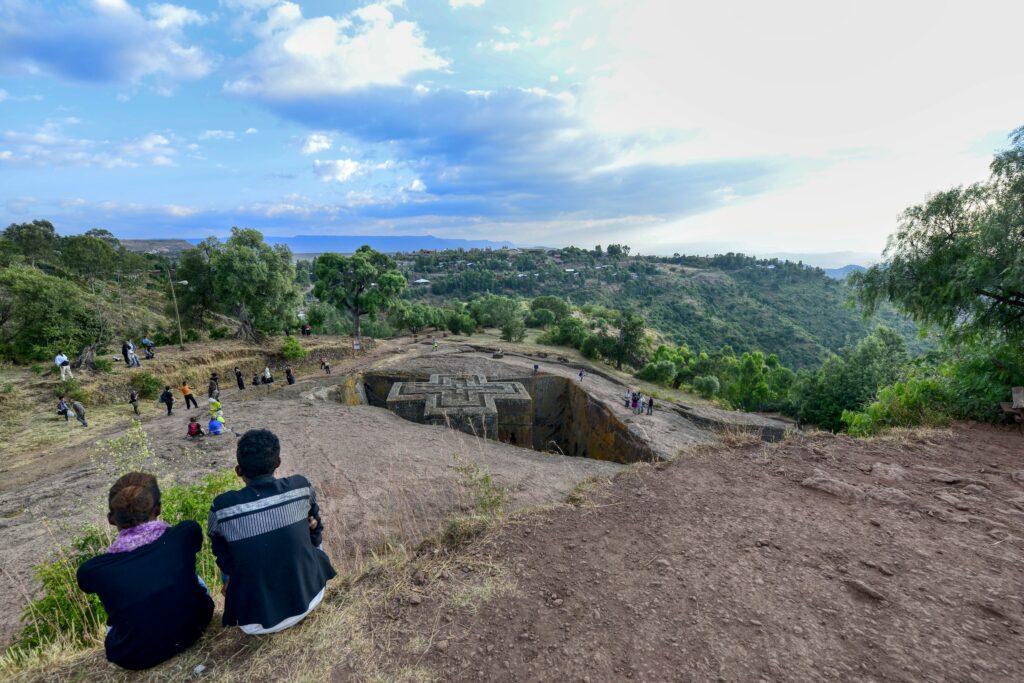Introduction
Lalibela, Ethiopia’s “New Jerusalem,” is a UNESCO World Heritage Site famed for its 11 medieval rock-hewn churches. Carved entirely from volcanic rock in the 12th century under King Lalibela’s divine vision, these architectural marvels remain active places of worship, offering travelers a profound spiritual and historical experience. Nestled in the rugged highlands at 2,500 meters (8,200 ft), Lalibela’s crisp mountain air, vibrant religious festivals, and warm hospitality make it a must-visit destination.
Why Visit Lalibela?
– UNESCO-listed rock churches – Explore monolithic structures like Bete Giyorgis (Church of St. George), a masterpiece of engineering and devotion.
– Living religious traditions – Witness chanting priests, candlelit ceremonies, and ancient rituals unchanged for centuries.
– Stunning landscapes – Hike to Asheton Maryam Monastery for panoramic views of terraced hills and jagged peaks.
– Authentic Ethiopian culture – Savor traditional coffee ceremonies, where the aroma of freshly roasted beans mingles with incense, and share meals of injera (sourdough flatbread) and spicy stews.

Planning Your Trip to Lalibela
Best Time to Visit
The ideal time to visit Lalibela is during the dry season (October–March), when temperatures are mild (15–25°C / 59–77°F) and rainfall is minimal. The clear skies and cool breezes make exploring the churches and hiking trails a joy. Avoid the rainy season (June–September), as trails become slippery and some roads may be impassable.
Key Events:
– Timkat (January 19–20) – Ethiopia’s Epiphany celebration, featuring vibrant processions where priests carry replicas of the Ark of the Covenant, accompanied by drumming and chanting. The energy is electric, and the streets are awash with color.
– Genna (January 7) – Ethiopian Christmas, marked by all-night church services. The faithful gather in white shawls, their voices rising in harmony under the stars.
Essential Items to Pack
- Sturdy hiking shoes – For uneven terrain in the church complexes and hikes to nearby monasteries.
- Light layers – Mornings can be chilly, but the sun warms the afternoons quickly.
- Headlamp – Essential for dimly lit underground tunnels connecting the churches.
- Cash (ETB) – Many places don’t accept cards, and ATMs are scarce.
- Respectful clothing – Shoulders and knees covered for church visits. A shawl is handy for draping over your shoulders when needed.
Personal Anecdote: During my visit, I forgot a headlamp and had to navigate Bete Maryam’s tunnels using my phone—lesson learned! The darkness was so profound that my phone’s light barely pierced it, and I stumbled more than once. A fellow traveler lent me their headlamp, a small act of kindness that made all the difference.
Local Transportation (Lalibela Travel Guide)
- Flights: Ethiopian Airlines operates daily flights from Addis Ababa (1.5 hrs, ~$100–$150). The small Lalibela airport is a scenic 30-minute drive from town.
- Buses: A 2-day bus ride from Addis (~$20), best for budget travelers. The journey is rough but offers stunning views of the Ethiopian highlands.
- Tuk-tuks & Taxis: Cheap for short trips (~$1–$3). Negotiate fares in advance to avoid overpaying.
3-Day Lalibela Itinerary
Day 1: Exploring the Northern Churches
Morning:
– Start at Bete Medhane Alem, the largest monolithic church in the world. Its towering pillars and ancient aura are humbling. Listen for the soft chants of priests echoing through the stone.
– Visit Bete Maryam, adorned with intricate frescoes depicting biblical scenes. The sunlight filtering through the windows casts a golden glow on the carvings.

Afternoon:
– Lunch at Ben Abeba Restaurant, a whimsical fusion of Ethiopian and Scottish design. Try the shiro stew (a spiced chickpea dish) or the kitfo (minced beef seasoned with chili and herbs). The terrace offers sweeping views of the valley.
– Explore Bete Golgotha, home to carved tombs said to hold the remains of King Lalibela himself. The air here feels heavy with history.
Evening:
– Attend a traditional coffee ceremony at a local home. The hostess roasts green coffee beans over coals, filling the room with a rich, smoky aroma. The coffee is served in tiny cups with a side of popcorn—a perfect end to the day.
Day 2: Southern Churches & Asheton Maryam
Morning:
– Tour Bete Gabriel-Rufael, a fortress-like church with a mysterious underground passage. The cool, damp air inside contrasts sharply with the sunlit courtyard.
– Visit Bete Abba Libanos, carved into a cliff face. Legend says it was built by angels in a single night.
Afternoon:
– Hike to Asheton Maryam Monastery (2–3 hrs). The trail winds through villages where children greet you with shouts of “Hello! Money!” The reward is a breathtaking view of Lalibela spread out below, the churches tiny specks in the distance.
Evening:
– Dinner at Seven Olives Hotel, a historic lodge serving tibs (sautéed meat with onions and spices). Eat by candlelight in the garden, serenaded by the night sounds of the highlands.
Day 3: Bete Giyorgis & Local Culture
Morning:
– Visit Bete Giyorgis (St. George’s Church), Lalibela’s iconic cross-shaped church. Descend into the trench, and as you round the corner, the church emerges like a mirage—perfectly symmetrical, utterly majestic.
Afternoon:
– Shop for handwoven scarves at the Lalibela Market. The vibrant colors and textures are irresistible, and bargaining is expected. A scarf should cost around 200–300 ETB (~$4–$6).
Evening:
– Relax with tej (honey wine) at a local bar. The sweet, slightly fermented drink is a favorite among Ethiopians. Sip slowly—it’s stronger than it tastes!
Pro Tip: Book a trip for deeper historical insights. A good guide can unlock the secrets of the churches, pointing out hidden carvings and sharing local legends.

Budget Considerations
- Budget: $30–$50/day (hostels, local meals).
- Mid-range: $70–$100/day (hotels, guided tours).
- Splurge: $150+/day (luxury lodges like Mountain View Hotel, private guides).
Sample Costs:
– Church entry: $50 (valid 5 days).
– Local meal: $2–$5.
– Tuk-tuk ride: $1–$3.
– Guided tour: $20–$30/day.
Safety & Cultural Etiquette
- Safety: Lalibela is safe, but avoid walking alone at night. Stick to well-lit areas.
- Dress modestly in churches (no shorts/sleeveless tops). Women may be asked to cover their hair.
- Ask before photographing priests or ceremonies. Some may request a small fee.
- Remove shoes before entering churches. The stone floors can be cold—bring socks!
Personal Anecdote: A local priest once invited me to share bread during a service—an unforgettable moment of connection. The bread, dense and slightly sour, was a symbol of welcome.
Frequently Asked Questions (FAQ)
1. Is Lalibela safe for solo travelers?
Yes! Petty crime is rare, but stay alert in crowded areas. Solo female travelers should dress conservatively to avoid unwanted attention.
2. How much does a Lalibela trip cost?
Budget travelers can manage on $30/day; tours cost extra. Mid-range travelers should budget $70–$100/day for comfort.
3. Can I visit Lalibela’s churches independently?
Yes, but a guide enhances the experience (~$20/day). They provide context and help navigate the complex layout.
4. What’s the best way to get to Lalibela?
Fly from Addis Ababa (1.5 hrs) or take a bus (2 days). Flights are more comfortable but pricier.
5. Are credit cards accepted?
No—bring cash (ETB). USD is sometimes accepted but at poor rates.
Conclusion
Lalibela is a journey through time, where ancient faith and breathtaking architecture collide. Whether you’re marveling at Bete Giyorgis or sipping tej with locals, this sacred town leaves a lasting impression. The echoes of chanting priests, the scent of incense, and the warmth of Ethiopian hospitality will linger long after you leave.
Start planning your Lalibela adventure today—before the crowds discover this hidden gem!
Keywords:
– Primary: “Best Lalibela travel guide”
– Secondary: “3-day Lalibela itinerary,” “Lalibela backpacking tips”
– Location-specific: “Bete Giyorgis,” “Lalibela tourism,” “Ethiopian rock churches”



